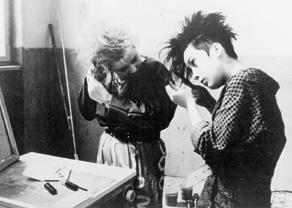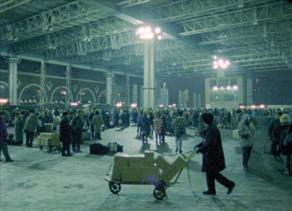
5 minute read
THE MURMUR OF THE WORLD
Winter Adé
SPHINX CINEMA - ZAAL 3
Advertisement
ZAT/SAT 1 APRIL 19:30
“The three structural elements in Winter Adé are the railroad journey, the intensive meetings with women, and the observation of daily life. The only fixed aspects of the film was that it begins with my birthplace in Zwickau and ends on a ferry on the sea. I definitely wanted to tell about myself in the beginning: by accident, I was born on the road, in an ambulance, right in front of a closed railway gate. And this fact leads into the concept of a railway journey. Of course, the railroad is a very important means of transportation in the GDR, but its meaning as a poetic symbol is also clear. It points to the existence of closed borders and also to the internal structure [of the country]: there are many tracks in life, but generally you can’t depart from the one you’re on because the switches are operated by someone else.”
Winter Adé
— After Winter Comes Spring
Helke Misselwitz
1988, DE, DCP, German spoken, English subtitles, 116 min Digitized and restored by DEFA
In 1987, kort voor de ineenstorting van de DDR, reisde Helke Misselwitz per trein van haar woonplaats bij Zwickau in het zuiden naar de noordkust van Oost-Duitsland. Onderweg ontmoette ze vrouwen van verschillende leeftijden en achtergronden, die ze filmde met een zeldzame tederheid en precisie. “Bijna veertig jaar lang is bij wet geregeld dat vrouwen juridisch en economisch gelijk zijn aan mannen,” aldus Misselwitz. “Maar wat is er in die veertig jaar gebeurd in het gedrag van mensen ten opzichte van elkaar? Dat is wat me interesseerde.” Verwijzend naar haar eigen biografie – ze werd geboren voor een gesloten spoorwegovergang – onderzoekt de filmmaker hoe vrouwen en meisjes leven in het “echte bestaande socialisme” en “hoe ze willen leven”. De vrouwen vertellen over hun teleurstellingen, verlangens en hoop: twee jonge punkers, een werkneemster in een brikettenfabriek, een Berlijnse econome of een 85-jarige dame die haar diamanten huwelijksjubileum viert. Nooit eerder waren mensen in de DDR zo openlijk en tegelijkertijd zo natuurlijk voor de camera verschenen om over hun omstandigheden en dromen te praten. De film met de programmatische titel “Vaarwel Winter” markeerde de onhoudbaarheid van het officiële standpunt. Het wees op een duidelijke omslag in de stemming in OostDuitsland, die een jaar later uiteindelijk uitbrak.
In 1987, shortly before the collapse of the GDR, Helke Misselwitz travelled by train from her home near Zwickau in the south to the north coast of East Germany. Along the way, she met women of different ages and backgrounds, whom she filmed with rare tenderness and precision. “For almost forty years, the law has established that women are legally and economically equal to men,” Misselwitz said. “But what has happened in those 40 years in people’s behaviour towards one another? That’s what interested me.” Referring to her own biography – she was born in front of a closed railway crossing – the filmmaker explores how women and girls live in “real existing socialism” and “how they want to live”. The women – two young punks, a worker in a briquette factory, a Berlin economist, an 85-year-old woman celebrating her diamond wedding anniversary – tell of their disappointments, desires and hopes. Never before had anyone in the GDR appeared so openly and at the same time so naturally in front of the camera to talk about their circumstances and dreams. With the programmatic title “Farewell Winter”, the film marked the untenability of the official stance. It pointed to a clear shift in the mood in East Germany, which finally broke out a year later.

Followed by a conversation between Helke Misselwitz and Kristofer Woods
In collaboration with Sabzian
SPHINX CINEMA - ZAAL 3
ZON/SUN 2 APRIL 11:30
“I originally wanted to work with a lot of languages. I had a lot of preconceived ideas, but it was through traveling a lot in those countries and finding things that interested me both in an emotional way and in a cinematic way that the film took shape. We made four trips. We were shooting a bit, but I knew the film was not there yet. So through the traveling I saw these people waiting and waiting and I thought that I should install myself next to them and that would be the film. So the shape was in my mind, but it was still very loose. And then I shot the material and through the editing I started to find the shape. I started to swim. And, in a way, that’s much more interesting than to just follow a story. It’s through cinema that you find the cinema.”
D’Est
— From the East
Chantal Akerman
1993, BE, DCP, sound, 107 min
Newly digitized and restored by CINEMATEK
Tussen 1991 en 1993, vlak na de val van de Berlijnse Muur, reisde Chantal Akerman door Midden- en Oost-Europa –naar Oost-Duitsland in de lente, naar Polen en Oekraïne in de zomer, en verder naar Moskou in de winter. “Ik wilde al twintig jaar naar Oost-Europa gaan,” aldus Akerman, “om er te werken met Slavische talen, die verschillend zijn maar vrij gelijkaardig klinken. Ik wilde een werk maken over veranderingen in stemmen en talen.” De film ontwikkelde zich echter, op de tast, tot een totaal andere vorm: terwijl de textuur van de klankband heel belangrijk is in D’Est, komt er geen enkel woord in voor. In de plaats ontvouwt zich een audiovisuele compositie van beklemmende impressies, zonder commentaar, dialoog of ondertitels. In lange takes onthult zich een wereld in suspensie, op de rand van een onbestemde toekomst. “Zonder te sentimenteel te doen zou ik zeggen dat er nog gezichten zijn die zich geven en bij momenten het gevoel van verlies doen vergeten, mensen op de rand van de afgrond die je van tijd tot tijd aangrijpen terwijl je het Oostblok doorkruist zoals ik net heb gedaan.”
Gevolgd door een gesprek met Pierre Mertens. Hij is een van de meest gerespecteerde geluidsrecorders en sound directors in België, die samenwerkte met filmmakers zoals Thierry Michel, Claudio Pazienza, Bruno Dumont, Agnès Varda en Elia Suleiman. Hij werkte aan verschillende films met Chantal Akerman, met name De l’autre coté, D’Est en La folie Almayer
Between 1991 and 1993, just after the fall of the Berlin Wall, Chantal Akerman travelled through Central and Eastern Europe – to East Germany in the spring, to Poland and Ukraine in the summer, and on to Moscow in the winter. “For already 20 years, I wanted to go to Eastern Europe,” said Akerman, “to work with Slavic languages, which are different but sound quite similar. I wanted to make a work about the changes in voices and languages.” However, the film developed, intuitively, into a completely different form: while the texture of the soundtrack is very important in D’Est, not a single word features in the film. Instead, an audiovisual composition of haunting impressions unfolds, without commentary, dialogue or subtitles. In a succession of long takes, a world in suspension, on the verge of an indefinite future, is revealed. “Without getting too sentimental,” she says, “I would say that there are still faces that offer themselves, occasionally effacing a feeling of loss, of a world poised on the edge of an abyss, which sometimes take hold of you, as you cross “the East” as I have just done.”
Followed by a conversation with Pierre Mertens. He is one of the most respected sound recordists and sound directors in Belgium, who worked with esteemed filmmakers such as Thierry Michel, Claudio Pazienza, Bruno Dumont, Agnès Varda, and Elia Suleiman. He worked on several films with Chantal Akerman, notably De l’autre coté, D’Est, and La folie Almayer.



